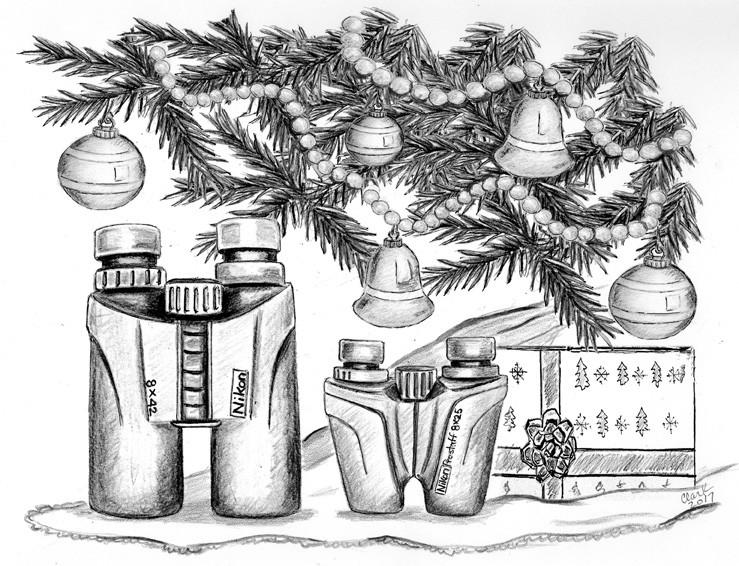
Dear Bird Folks,
I borrowed a pair of my friend’s 8X42 binoculars and really liked them. I thought I’d get the same kind for myself, but my husband thinks buying a set of binoculars with a zoom feature is a better idea. What do you think I should do?
– Lizzie, Falmouth, MA
Get a new husband, Lizzie,
That’s what I think you should do. Your husband might be great at choosing a life partner, but he’s way off when it comes to buying binoculars. I put zoom binoculars in the gimmick category, just like all the other stuff found on the back pages of magazines or featured as “clickbait” on the internet. These ads try to entice us to buy supplements that will miraculously improve our memories or purchase devices promising to help shrink certain body parts (or make other parts grow larger). They invariably offer things “the experts don’t want you to know about.” (FYI: The experts don’t care what we know. They just don’t.) Somewhere on this ever-growing list of sketchy items you’ll find zoom binoculars. Don’t buy them.
Traditional binoculars, such as your friend’s 8X42 model, make an object (a bird, hopefully) eight times larger. Zoom binoculars, with just a flip of a lever, lets you increase the size of the object from eight times larger to perhaps twenty times. This sounds like a good idea. It’s not. When magnification is increased, the viewed image becomes darker, which isn’t ideal. In addition, because these binoculars are made for people who don’t know any better (sorry, hubby), zoom binoculars tend to be optically inferior, which also isn’t ideal. But the biggest problem on this list of problems is stability. Humans, even when we are stone-cold sober, aren’t very steady. Just the act of breathing alone creates movement. This is why high-powered telescopes, spotting scopes and fancy cameras are set on tripods. A zoom feature on binoculars increases the power, but it also magnifies our hand shaking, which creates a blurry image. I know a higher power is important to some folks, but it shouldn’t be in this case.
Another issue with zoom binoculars is they tend to be fragile, even more fragile than binos already are. I remember reading a story in the Boston Globe about an optical repair company. The quote that sticks in my mind was from a technician who told the reporter, “We don’t sell zoom binoculars, but we sure do fix a lot of them.” Enough said.
The last piece of evidence on why zoom binoculars aren’t a good idea is the most damning of all: birders don’t use them. Gimmicky binoculars might be okay for sports fans, foreign spies and peeping Toms, but birders have no use for anything that isn’t first-rate. This is why birders dress like they do; all their money is spent on pricey optics and not fashion. Enough said. While I’m on the topic of gimmicks, occasionally someone will ask for “focus-free binoculars,” an item that somehow still exists. Focus-free binoculars don’t have a focus wheel, but instead have a huge depth of field; thus, everything you look at is in focus…or so they claim. Without an adjustment to help sharpen the image, it becomes like looking through somebody else’s eyeglasses (a bad idea). Focusing a pair of binoculars is one of the least strenuous activities in the world. If you’re too tired to use a finger to turn a focus wheel, then maybe it’s not your day to go for a bird walk.
The binos your friend let you borrow, the ones you said were 8X42, are a good choice. The “8” means everything you look at will be eight times larger, which is the magnification most folks can handhold without requiring help from a tripod. The other number, “42,” simply refers to the size (in millimeters) of the two big lenses in the front. Many people think this number is related to the field of view, meaning the larger that number is the more they’ll see. Nope. Larger lenses help with light gathering, especially when there’s limited sunshine. When the sun is shining brightly, however, the larger lenses, which can be bulky and heavy, are less beneficial, and the reason why some folks prefer smaller, compact binoculars.
In the old days, I would tell folks to find a camera shop or a sporting goods store in order to try out various styles of binoculars. Much like selecting an easy chair, the best way to find out if binoculars fit you (your hands and face, not the body part that goes onto the chair) is to try them firsthand. Unfortunately, online shopping has made these stores obsolete; very few places stock optics anymore. Now I tell people to do what you did: borrow or at least try a friend’s pair of binoculars in order to determine what size and shape work best for you. The final thing to consider when choosing binoculars is the price, and here is where it gets tricky.
Some folks will tell you to buy the best binoculars you can afford, Lizzie, but I’m not totally sold on that advice. If the only things you hope to see with binoculars are birds on your feeder, or perhaps whales just offshore, then don’t spend a lot of money. However, if you eventually want to try and sort out all of the Cape’s different sparrows and generic-looking sandpipers, then absolutely break the bank. In this case, top quality optics will make a difference. Don’t worry if it cuts into your fashion budget. No matter how you dress while you are out birding, other birders will never notice…unless you’re using zoom binoculars. Then they’ll notice for sure.